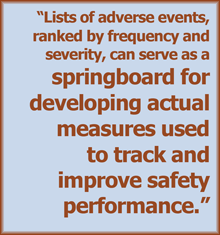Synopsis
To identify measures of patient safety for hospital surgery and intensive care units, researchers conducted brainstorming sessions with physicians and nurses. This process, which can be easily replicated, produced safety measures deemed credible by practitioners on the front lines of care.
 The Issue
The Issue
No comprehensive, universally accepted methods exist for tracking hospitals' performance on patient safety, though such measures are essential to improving care. To design hospital safety measures that will be deemed valid by all the clinicians working in a given hospital unit, it is crucial to obtain and incorporate feedback from surgeons, nurses, anesthesiologists, and other members of the care team. In this Commonwealth Fund–supported study, researchers asked physicians and nurses to identify what they considered to be the most frequent and most severe patient harms occurring in intensive care units (ICUs) and in general surgery.
Key Findings
- To compile the lists, the researchers conducted brainstorming sessions with physicians and nurses. Additional steps included working with an advisory panel with expertise in patient safety measurement.
- Using this process, the researchers identified acute renal failure, pressure ulcers, and hospital-acquired bloodstream infections as the most frequent patient harms in the ICU. The most severe harms were anoxic brain injury, pulmonary embolism, and stroke.
- Eight ICU patient harms were identified as both frequent and severe: acute renal failure, hospital-acquired bloodstream infection, cardiac arrhythmia, gastrointestinal bleed, MRSA infection, sepsis, acute lung injury, and adverse drug events.
- In general surgery, the most frequent patient harms identified were bleeding/hemorrhage/hematoma, deep-vein thrombosis, and delirium; the most severe harms were cardiac arrest requiring CPR, stroke, and death.
- Six surgical patient harms were listed as both frequent and severe: bleeding/hemorrhage/hematoma, respiratory failure, pressure ulcer, sepsis, pulmonary embolism, and wound dehiscence (poor wound-healing).
Addressing the Problem
The focus groups represented an effective, easily replicable method for producing credible safety metrics acceptable to all clinicians on a care team, the researchers say. If this process were to be repeated nationwide with ICUs and general surgery units, it "would be possible to generate a 'master list' of patient harms that could be used by all ICUs and general surgical services," note the authors. Further development and testing, and the eventual creation of standard metrics, would allow clinicians in all hospital units to consistently measure and track safety performance, leading to improved patient safety.
About the Study
The researchers used a four-step process to identify patient harms. After first reviewing the published literature on measures of patient harms, they held seven brainstorming sessions with 57 ICU and general surgery physicians and nurses at four hospitals in Boston and Baltimore, at which participants developed lists of the most frequent and most severe patient harms. The researchers next compiled a master list of harms and asked the participating clinicians, via e-mail, to identify the 20 most frequent and 20 most severe harms. As a final step, the researchers assembled an expert advisory panel of clinicians and health services researchers to review the lists.
The Bottom Line
Incorporating practitioners' experiences and perspectives is crucial for the development patient safety measures. The model tested in this study can be used to design safety measures that are both comprehensive and credible with clinicians in hospital units across the country.